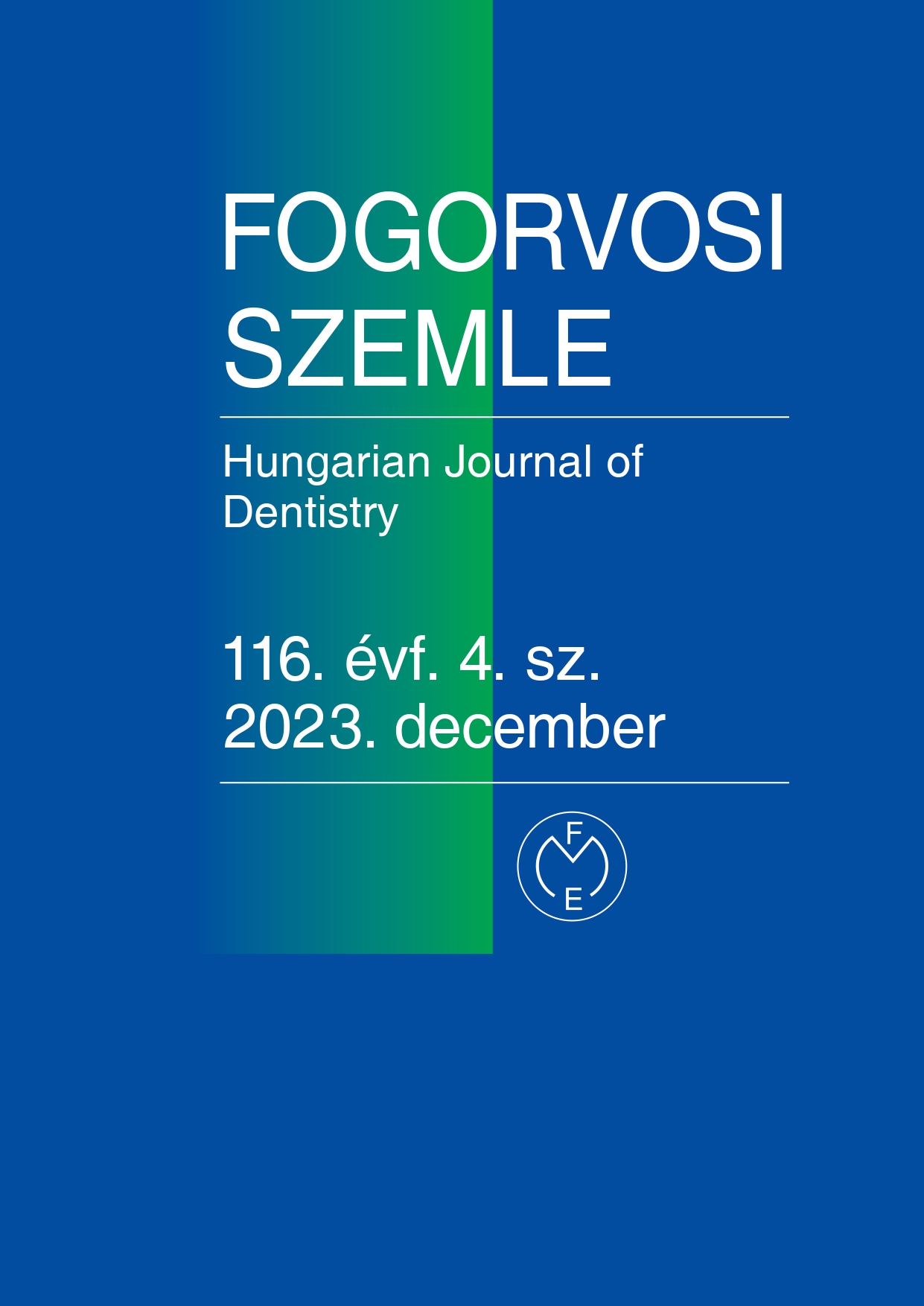Complex prosthetic rehabilitation of a patient with amelogenesis imperfecta with digital workflows
Abstract
Introduction: Amelogenesis imperfecta (AI) is a diverse collection of inherited diseases that show quantitative and qualitative
defects in tooth enamel in the absence of systemic manifestations. Patients with AI often have open bite, which
also requires complex care. In the final dental treatment, the focus should be on the preparation of indirect restorations,
so early detection and care can be key factors for long-term success, as poor-quality enamel can be more easily attacked
by caries.
Case report: A 15-year-old young female patient presented to the Department of Prosthodontics of Semmelweis University
in 2022 because of her worn down teeth due to amelogenesis imperfecta. The patient also had open bite. During
the intraoral examination, reduced enamel was detected on all teeth, with partial enamel breakdown, exposing the
dentin. Following the current professional recommendations, we planned monolithic zirconia crowns and splints as well
as bridges to correct the tooth gaps on the upper and lower arches. In the first phase of the treatment, we increased the
occlusal vertical dimension using a gothic arch tracer and digital face bow (Zebris for Ceramill). The impressions were
taken by the 3Shape Trios 3 Pod, making it more comfortable for the patient and easier to copy accurately the increased
occlusal vertical dimension from the temporary restoration to the final restoration. Due to the damaged tooth structure,
for the final cementation resin modified glass ionomer was used. Protecting the monolithic zirconia restorations, the temporomandibular
joint and the muscles, a Michigan-splint was created for the patient.
Summary: For patients with AI, the appearance of the teeth can cause psychological and functional problems, so the
goal of every treatment plan is restoration, and regular follow-up. Maintaining proper oral hygiene is also essential for
patients with AI, and according to the literature, treatment with indirect restorations increases success compared to direct
treatments.
References
Ortiz L, Pereira AM, Jahangiri L, Choi M: Management of Amelogenesis Imperfecta in Adolescent Patients: Clinical Report. J Prosthodont 2019; 28 (6): 607–612. https://doi.org/10.1111/jopr.13069
Toupenay S, Fournier BP, Manière MC, Ifi-Naulin C, Berdal A, de La Dure-Molla M: Amelogenesis imperfecta: therapeutic strategy from primary to permanent dentition across case reports. BMC Oral Health 2018; 18 (1): 108. https://doi.org/10.1186/s12903-018-0554-y
Strauch S, Hahnel S: Restorative Treatment in Patients with Amelogenesis Imperfecta: A Review. J Prosthodont 2018; 27 (7): 618–623. https://doi.org/10.1111/jopr.12736
Gadhia K, McDonald S, Arkutu N, Malik K: Amelogenesis imperfecta: an introduction. Br Dent J 2012; 212 (8): 377–379. https://doi.org/10.1038/sj.bdj.2012.314
Slayton RL, Warren JJ, Kanellis MJ, Levy SM, Islam M: Prevalence of enamel hypoplasia and isolated opacities in the primary dentition. Pediatr Dent 2001; 23 (1): 32–36.
Jedeon K, De la Dure-Moll a M, Brook es SJ, Loiodice S, Marciano C, Kirkham J, et al: Enamel defects reflect perinatal exposure to bisphenol A. Am J Pathol 2013; 183 (1): 108–118. https://doi.org/10.1016/j.ajpath.2013.04.004
Alachioti XS, Dimopoulou E, Vlasakidou A, Athanasiou AE: Amelogenesis imperfecta and anterior open bite: Etiological, classification, clinical and management interrelationships. J Orthod Sci 2014; 3 (1): 1–6. https://doi.org/10.4103/2278-0203.127547
Fell er L, Kramer B, Raubenheimer EJ, Lemm er J: Enamel dysplasia with hamartomatous atypical follicular hyperplasia (EDHFH) syndrome: suggested pathogenic mechanisms. Sadj 2008; 63 (2): 102–105.
Pouls en S, Gjørup H, Haubek D, Haukali G, Hintze H, Løvsc hall H, et al: Amelogenesis imperfecta – a systematic literature review of associated dental and oro-facial abnormalities and their impact on patients. Acta Odontol Scand 2008; 66 (4): 193–199. https://doi.org/10.1080/00016350802192071
Azpiazu-Flores FX, Knobloch LA, Larsen PE: Interdisciplinary Management of a Patient with Dentinogenesis Imperfecta Type II Using a Combination of CAD-CAM and Analog Techniques: A Clinical Report. J Prosthodont 2022; 31 (8): 647–654. https://doi.org/10.1111/jopr.13556
Coachman C, Bohner L, Jreige CS, Sesma N, Calamita M: Interdisciplinary guided dentistry, digital quality control, and the “copy-paste” concepts. J Esthet Restor Dent 2021; 33 (7): 982–991. https://doi.org/10.1111/jerd.12736
Faria-e-Silva AL, De Moraes RR, Menezes Mde S, Capanema RR, De Moura AS, Martelli H, Jr: Hardness and microshear bond strength to enamel and dentin of permanent teeth with hypocalcified amelogenesis imperfecta. Int J Paediatr Dent 2011; 21 (4): 314–320. https://doi.org/10.1111/j.1365-263X.2011.01129.x
Markovic D, Petrovic B, Peric T: Case series: clinical findings and oral rehabilitation of patients with amelogenesis imperfecta. Eur Arch Paediatr Dent 2010; 11 (4): 201–208. https://doi.org/10.1007/bf03262745
Copyright (c) 2023 Authors

This work is licensed under a Creative Commons Attribution 4.0 International License.


.png)




1.png)



